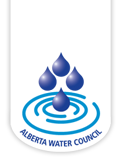About the Council’s Drought Resources
Drought can be described as a prolonged period of dry weather that depletes water resources (e.g., rivers, streams, lakes, wetlands, groundwater, reservoirs, dugouts, and soil moisture). There are several mechanisms by which drought can occur, its duration can be variable (e.g., decades to weeks) and it may have unique impacts to the economy, communities, and the environment.
In several parts of the province, there has been an increase in droughts and water shortages over the past few years. El Niño is causing a warmer and drier winter across Canada and over 70 per cent of the country is experiencing drought. In Alberta, we depend on snow packs and precipitation for most of our water supply. According to Alberta Environment and Protected Areas, this winter, snowfall is well below average, many rivers are at or near record lows and multiple reservoirs remain below capacity. We are in water shortage management stage 4 (out of 5) where several water management areas are being impacted and there is a likelihood drought conditions may worsen.
Using its diverse, multi-stakeholder platform, the Alberta Water Council (AWC) continues to bring together its partners to support drought management efforts. The Council has developed several resources to help local municipalities and in turn Albertans prepare for, mitigate, and recover from drought. Below are detailed descriptions of each initiative and where information can be found.
Building Resiliency to Multi-Year Drought in Alberta Guide and Supporting Documents
In 2020, the Council publicly released a Building Resiliency to Multi-Year Drought in Alberta Guide, a companion report, as well as workshop and communication materials.
This guide is intended for small urban and rural communities, including towns, villages, and municipal districts. The purposes of the guide are twofold: to document lessons learned from previous droughts in Alberta, thereby increasing public awareness of the importance of conserving water, and to bring together the most current information, tools, and resources as a reference for communities before, during, and after a multi-year drought. While the guide was built with the objective of supporting small communities, much of the content is also applicable to larger municipalities and other organizations and is also relevant for short-term droughts. To view the guide and its related resources, please see here.
Some Watershed Planning and Advisory Councils (WPACs) and their partners, are utilizing the AWC’s Guide and its resources to host workshops in communities experiencing drought. For more information about these workshops, please contact your area’s WPAC here.
Improving Drought Resilience in Alberta Through a Simulation Report
Leveraging the foundation made by the previous work to create a Guide, the AWC focused its efforts on hosting a simulation for communities to test their proposed drought management structures, communication channels, tools, and resources in a workshop environment. By testing these aspects, the findings would inform the Government of Alberta (Gos), municipalities, Indigenous communities, and others to better understand and plan for drought.
The final report details information on a literature review, how the simulation was held, findings from the exercise, lessons learned, and the Council’s recommendations. The final report was publicly released in February 2024 and can be found here.
Drought Mutual Support Committee
Given growing concerns about drought in Alberta, the AWC established a committee to support ongoing efforts. The intent of this committee is to support communication, collaboration, and coordination on drought efforts as well as messaging among water-users, decision-makers, interested and impacted Albertans, and groups involved in the various aspects of water management.
For updates and information about the committee’s work, please see here.
Related Information and Resources
Below is a list of related information and resources:
- Drought, Government of Alberta
- Alberta River Basins, Government of Alberta
- Alberta Rivers: Data and Advisories, Government of Alberta
- Water Shortage Management Stages, Government of Alberta
- Agricultural Moisture Situation Update, Government of Alberta
- Alberta Climate Information Service Data Products and Tools, Government of Alberta
- Canada Drought Monitor, Government of Canada
- Groundwater Observation Well Network, Government of Alberta
- Drought in 21st Century Alberta, Alberta WaterPortal Society
- North American Drought Monitor, National Drought Mitigation Centre
- Drought Relief Support for Livestock Producers, Government of Canada and Government of Alberta
- Preparing water shortage response plans, Government of Alberta
- Drought Resilience Plan, City of Calgary
- Drought Watch and agroclimate, Government of Canada
- Municipal Flood and Drought Action Planning Primer, Miistakis Institute
- Adapt-action Tool, Miistakis Institute
- A Guide for Declaring Municipal Agricultural Disasters in Alberta, Rural Municipalities of Alberta
- Community Toolkit for Economic Recovery and Resiliency, Economic Developers Alberta
- Handbook of Drought Indicators and Indices, World Meteorological Organization
- M60 Drought Prepardness and Response, American Water Works Association
